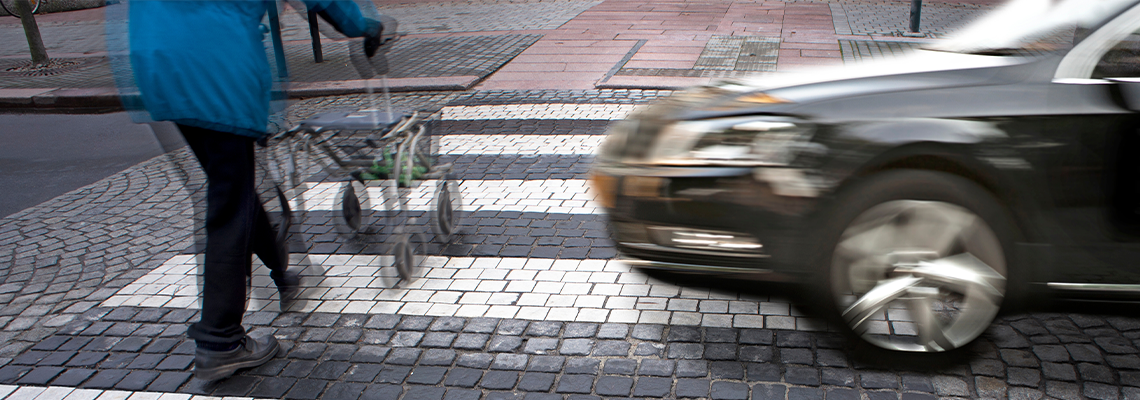
How Is Fault Determined in Pedestrian Accident Cases?
Determining fault in pedestrian accident cases can be a complicated process. Whenever pedestrians and vehicles collide, emotions often run high. However, the legal system relies on evidence, rules, and clear legal principles to identify who bears responsibility.
At Abrahamson Law Office, we are committed to helping our clients understand these processes while fighting for their rights every step of the way.
Understanding how fault is determined in pedestrian accident cases can prepare both pedestrians and drivers for how they can assert their rights. Here, we aim to break down Nebraska's comparative negligence rules, the role of evidence, and your legal obligations in these situations to help strengthen your case.
Nebraska’s Comparative Negligence Rule
Nebraska follows a modified comparative negligence rule. This means that, under Nebraska Revised Statute § 25-21,185.09, a person can only recover damages if they are less than 50% at fault for an accident. If you are found to be 50% or more responsible, you will be barred from receiving any compensation.
For example, if a pedestrian crosses a street outside of a designated crosswalk (jaywalking) and is struck by a driver who was speeding. The court might determine that both parties share responsibility. The pedestrian’s failure to use a crosswalk might result in them being 40% at fault, while the driver’s excessive speed could be 60% at fault.
Under Nebraska law, the pedestrian could still recover damages since they are less than 50% responsible. However, their total compensation would be reduced by 40%. This rule emphasizes the importance of convincing evidence to prove who was at fault and to what extent they contributed to the accident.
Important Evidence for Determining Fault After a Pedestrian Accident
In order to determine fault in a pedestrian accident, you will need to present strong evidence. In these cases, determining fault relies heavily on factual findings to establish who was at fault and to what degree. The primary types of evidence you should collect following a pedestrian accident include the following.
Police reports: Officers responding to an accident scene will often create a formal report of the accident that documents critical details, including witness statements, descriptions of the scene, and violations of traffic laws. These reports can carry significant weight in demonstrating fault. If the officer does not offer you a report, request one.
Witness testimony: Neutral third parties who observed the accident can provide valuable insights into what occurred. Their testimony is often used to corroborate or challenge the claims made by either party.
Surveillance footage: Traffic cameras, security systems, or dashcams can provide clear visual evidence of what occurred during the accident.
Accident scene documentation: Photos or videos of the scene taken shortly after the incident that show skid marks, vehicle damage, or the position of the pedestrian and the driver can help recreate the events leading up to the accident.
Medical records: These records not only detail the extent of injuries but can also establish a direct link between the accident and the harm suffered.
If you or someone you know has been injured in a pedestrian accident in Nebraska, it's important to take immediate steps after an accident to collect the evidence you need and to protect your rights. An experienced personal injury attorney can help you better understand your obligations and the evidence you should collect in your specific case.
Legal Obligations of Drivers and Pedestrians Can Help Establish Fault
In Nebraska, both drivers and pedestrians have a legal responsibility to prevent accidents from happening wherever possible. However, when accidents happen, establishing whether a pedestrian or a driver violated these obligations can help determine fault.
Driver Responsibilities
Under Nebraska law, drivers have certain duties to other drivers, cyclists, and pedestrians when operating a vehicle. These responsibilities include, but are not limited to, the following:
Yielding the right of way to pedestrians in crosswalks
Obeying all traffic signals and speed limits
Exercising caution in areas with high pedestrian activity, such as school zones
Avoiding distracted or impaired driving
When a driver fails to meet these obligations, they can often be found at fault for a pedestrian accident. For example, if a driver fails to stop at a red light and strikes a pedestrian crossing at a marked crosswalk, they breached their duty of care and would likely be found liable.
Pedestrian Responsibilities
While pedestrians enjoy certain protections under Nebraska law, they also have certain obligations toward drivers. These responsibilities often include the following:
Obeying traffic control signals, such as crossing only when the walk light is green
Using designated crosswalks wherever possible
Refraining from sudden or unpredictable entry into roadways
When pedestrians fail to uphold these responsibilities, their actions may contribute to an accident, and consequently, they could be found at fault for the accident. For example, if a pedestrian suddenly darts into traffic without checking for oncoming vehicles, even if the driver was adhering to the speed limit, the pedestrian could be held liable for the accident.
Nebraska's Modified Comparative Fault Rule
Nebraska follows a modified comparative fault rule to determine liability in cases where both the driver and pedestrian share some degree of fault for an accident. Under this rule, if a pedestrian is found to be more than 50% at fault for an accident, they are barred from seeking any compensation for their injuries or damages.
However, if the pedestrian is found to be 50% or less at fault, their compensation will be reduced by their percentage of fault. For example, if a pedestrian is deemed 40% at fault for an accident and seeks $10,000 in damages, they will only receive $6,000 (60% of $10,000) as compensation.
What to Do Following a Pedestrian Accident
If you've been involved in a pedestrian accident, there are several steps you should take immediately following the collision to protect your rights and gather evidence for a potential personal injury claim.
Call law enforcement: Call local law enforcement immediately after being involved in a pedestrian accident. Request medical assistance for any injured parties and make sure the police file an official accident report.
Seek medical attention: Even if you don't think your injuries are serious, seek medical attention from a licensed medical professional. Some injuries may not be immediately apparent, and receiving treatment as soon as possible can prevent any potential long-term issues. Additionally, medical attention also creates a record of your injuries and can be used as evidence in any legal proceedings.
Gather information: While at the scene of the accident, gather as much information as possible. This includes obtaining contact information from any witnesses, taking photos of the accident scene and any injuries you may have sustained, and exchanging insurance information with the driver involved.
Consult an experienced attorney: Contact a skilled personal injury attorney who can help you create a robust case. Our attorneys are Abrahamson Law Office have years of experience helping those who have been injured in a pedestrian accident.
Contact your insurance company: As soon as possible after the accident, contact your insurance company to inform them of what has happened. They can advise you on next steps and help guide you through the claims process. However, be careful not to say anything to the insurance company without speaking to your lawyer first.
Consider legal action: If you have sustained serious injuries or significant damage to your vehicle, it may be necessary to consider taking legal action against the responsible party, especially if you are unable to reach a settlement.
How an Attorney Can Help
Determining fault in pedestrian accident cases often requires a nuanced understanding of legal principles and the ability to argue effectively with evidence. At Abrahamson Law Office, we have handled many cases involving these complicated legal scenarios. Whether you’re a pedestrian injured in an accident or a driver seeking to defend yourself against a claim, we’re here to make sure your side of the story is heard.
Our team is skilled in compiling evidence, navigating Nebraska’s comparative negligence laws, and negotiating with insurance companies. If needed, we’re fully prepared to advocate for you in court.
Reach Out to an Experienced Attorney Today
If you’ve been involved in a pedestrian accident, it's important to understand your rights and contact an attorney as soon as possible. At the Abrahamson Law Office, we are experienced in helping those involved in pedestrian accidents pursue the compensation they need.
Located in Omaha, Nebraska, we serve clients throughout Sarpy County, Douglas County, and the surrounding areas. Contact us today to schedule a consultation.
